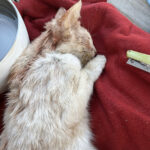Beating The Heat
Battling the Texas heat with 150 outdoor cats is no easy feat! We have come up with some easy methods and inexpensive devices to help ease the effects of extreme temperatures.
Shelters
Insulated shelters keep cats cool in the summer and warm in the winter. Homemade feral cat houses include a large Tupperware container with a smaller, Styrofoam igloo placed inside. Straw can be added too and a hole in the front and rear for easy entry and exiting. There are some online videos on how to make these simple shelters for outdoor cats.
Large cardboard boxes laid on their sides offer some cooling properties and we all know cats love hiding in boxes!

Plenty of Fresh Water
Cats also need plenty of fresh, cool water in the summer. We purchased a small refrigerator to place jugs of water in to replenish water bowls.
Additionally, large water bowls can be placed in the freezer overnight, keeping water cool for up to 15 hours.
Cats are more likely to drink running water, so fountains offer an excellent way to encourage cats to drink more water all year long.
There are so many different cat water fountains that I don’t want to recommend one but a quick Google search will yield numerous options.
Kidney disease is one of the most common struggles cats face and staying hydrated is key in preventing this deadly feline disease.
Providing wet canned cat food and hydrating nutritional supplements help ensure cats are staying hydrated. Most of the cats love this supplement and it’s wonderful for sick and elderly cats who tend to not drink as much water as well.

Cooling Pads
Finally gel cooling pads are a fan favorite during hot summers at the Sanctuary. While more often used for dogs, these multi-species cooling pads work great for cats as well. Some are filled with water and others are activated with body weight. These can be used in kennels and in popular cat resting spots.
Special care should be given to kittens and elderly cats who are less able to acclimate to extreme temperatures. Enclosed areas that offer air conditioning in the summer and heating in the winter help mitigate the effects of harsh climates.








